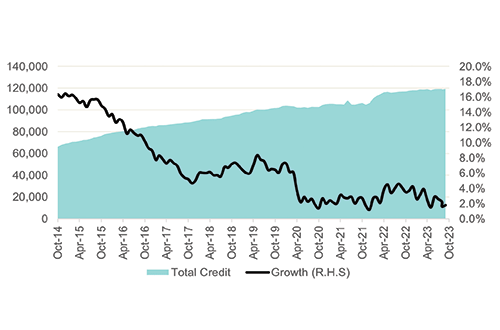The repo rate is expected to be held steady at 7.75% – and as a result, the prime lending rate at commercial banks is anticipated to remain unchanged at 11.5% when the Bank of Namibia’s Monetary Policy Committee meets for the last time this year on Wednesday, 6 December.
This is according to stock brokerage Simonis Storm, who noted this expectation is in line with the South African Reserve Bank’s (SARB’s) decision to keep the repo rate at 8.25% during its latest meeting on 23 November 2023.
“While maintaining the current rate may not significantly alleviate the interest rate burden for businesses, households and consumer disposable income, it does avoid further financial tightening that a rate increase would entail. This stability in interest rates provides a measure of relief and steadiness in the financial landscape,” SS noted in its latest report on Public Sector Credit Extension (PSCE). The report noted that during October 2023, PSCE in Namibia increased modestly to 1.8% year-on-year (y/y), which was a slight improvement from the 1.6% y/y observed in September 2023.
“However, this represents a decline when compared to the 3.5% y/y growth in October 2022. This relatively low growth rate, which is the second lowest recorded in 2023 and falls beneath the 2% mark, indicates a subdued credit market. The total credit extended to the private sector reached N$119.3 billion at the end of October 2023. This modest uptick in PSCE can be largely attributed to the household sector, which notably experienced an increase in overdraft facilities extended to individuals. Conversely, credit extension to corporate entities continued its downward trajectory,” the SS report reads.
Meanwhile, by the end of October 2023, the liquidity position of the domestic banking sector showed an improvement, with SS noting the industry’s cash balances rose to N$7.5 billion – up from N$7.4 billion in September 2023.
“This increase is due to government bond payments made during October 2023. Concurrently, there was a 4.4% month-on-month (m/m) decline in the central bank’s international reserves, falling to N$51.4 billion in October 2023 from N$53.8 billion in September 2023. This decrease is mainly attributed to increased commercial bank outflows, driven by higher import bills,” the SS report stated.
SS further pointed out that corporate credit uptake has remained in a negative trend for the seventh consecutive month, contracting by 1.4% y/y.
The stock brokerage noted this represents a slight improvement, compared to the 2.1% y/y contraction recorded in September 2023, stating: “From an economic growth standpoint, this persistent negative trend is concerning. The robust extension of credit to the corporate sector is usually critical for driving overall economic growth”.
Moreover, the stock brokerage emphasised that household credit extension remains a key driver in PSCE growth by exhibiting a moderate increase of 4.2% y/y in October 2023.
This, SS stated, is an escalation from the 2.8% y/y growth witnessed in October 2022, albeit a slight decrease from the 4.3% y/y recorded in September 2023.
The SS analysis showed the observed decline in household credit extension during this period can largely be attributed to a decreased demand across various categories, including other loans and advances, mortgage credit, as well as instalment sales and leasing.
“However, household overdraft credit saw a significant surge, growing by 25.1% y/y in October 2023, marking a substantial rebound from the -0.3% y/y recorded in the corresponding period last year. Notably, this positive trajectory in household credit extension has occurred against the backdrop of elevated inflation and interest rates,” SS noted. The report also noted that during October 2023, overdraft credit increased primarily due to high demand from the household sector, while overdraft lending to corporate sector remained in contraction territory. SS emphasised that other loans and advances also contracted by 0.4% y/y in October 2023, driven by diminished demand from the business sector. “In contrast, mortgage credit growth experienced a downturn in October 2023, registering a growth rate of 1.0% y/y, a decrease from the 1.2% y/y recorded in September 2023. This sluggish expansion in the mortgage credit segment is primarily due to net repayments made by the corporate sector,” SS stated.
SS continued that on a positive note, instalment sales and leasing credit continue to exhibit a continuous upward trajectory, with an annual growth rate of 9.4% y/y in October 2023.
This is while instalment and leasing credit experienced a deceleration on a m/m basis, falling from the 11.6% growth observed in September 2023.
SS attributed this slowdown largely to a reduction in leasing facilities provided to corporations within the retail industry.


